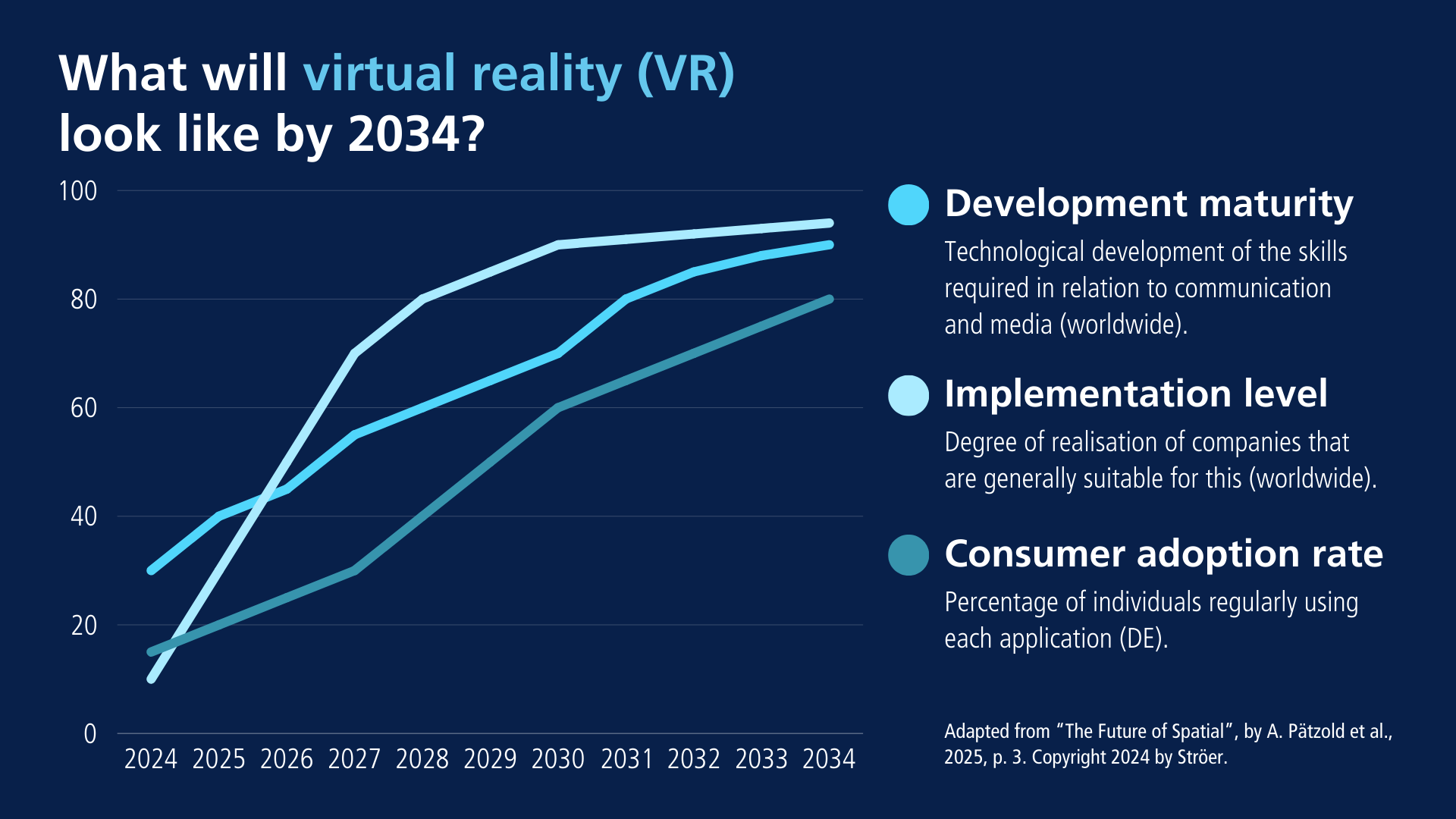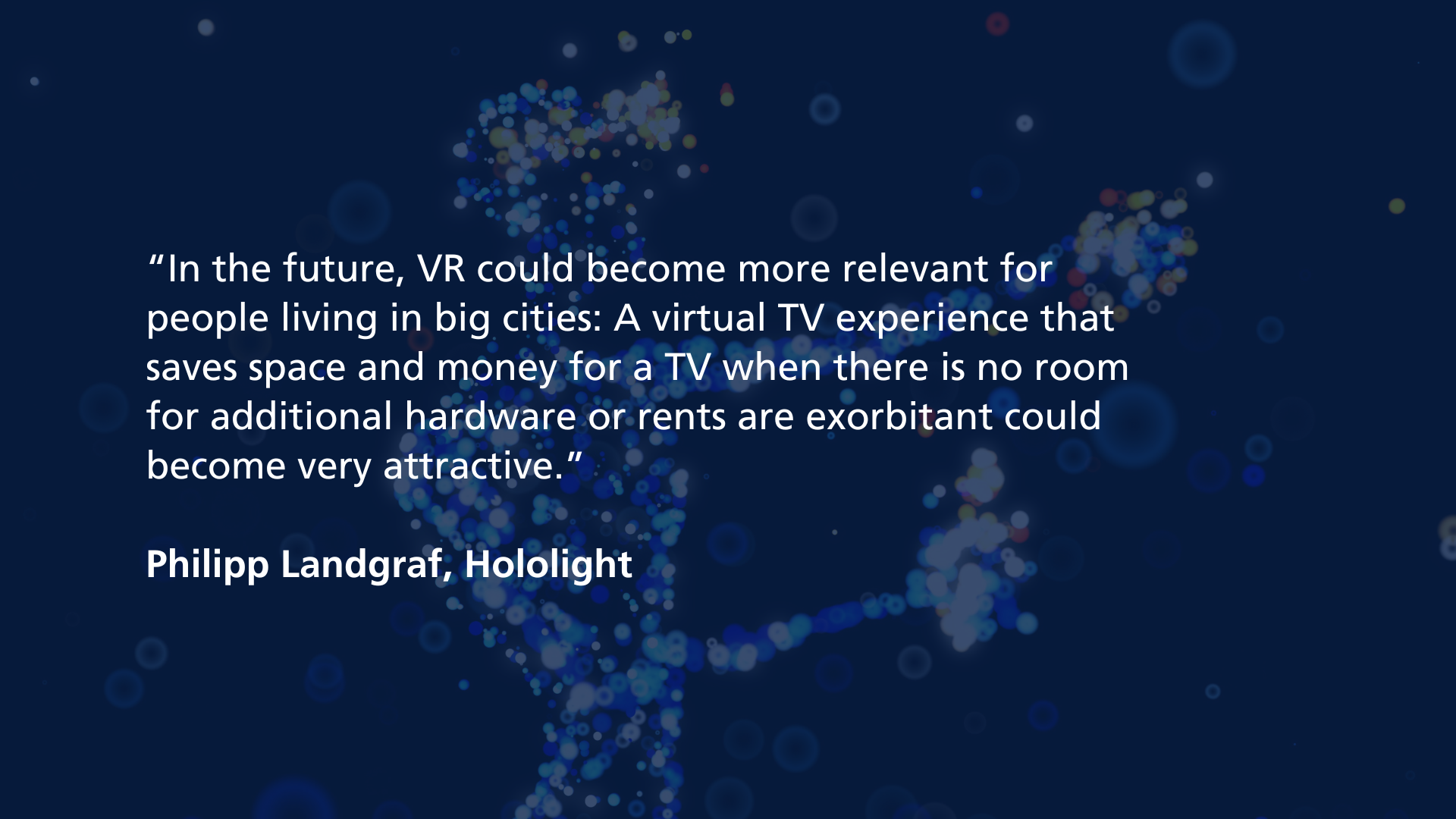
27. March 2025
Spatial outlook with Philipp Landgraf, Senior Director XR Streaming at Hololight
The growth and proliferation of virtual worlds and the digitisation of the analogue world have been trending topics for some time now. In 2012, Oculus VR (now Meta) heralded a new era with the launch of the Oculus Rift. In Germany, the fifth largest market for virtual reality (VR) technology, we are lagging behind the US and Chinese markets and are struggling to adopt it.
Until now. What has changed recently and why will the big momentum start in 2025?
As part of our recently published Crossroads essay “The Future of Spatial”, we spoke to expert Philipp Landgraf, Senior Director XR Streaming at Hololight and responsible for strategic partnerships. Hololight is a leader in augmented reality (AR) and virtual reality (VR) technologies for industrial applications. Founded in 2015, the company focuses on the development of XR software, infrastructure and streaming technology for enterprises.
Status quo or:
Why VR is gaining dominance
In recent years, the focus has often been on augmented reality (AR) applications. AR and VR were then combined and theoretically referred to as Mixed Reality (XR). VR is now becoming much more relevant. This is not because the technology is superior per se, but because it works much better now and is becoming increasingly dominant: on the last Prime Day, more Meta Quests (VR headset from Meta) were sold than AirPods – a strong signal of the growing market. The fact that Apple positioned itself in the market with the Vision Pro 2024 was also a positive and trend-setting sign. However, the price of the Apple Vision Pro is still a major hurdle.
Today, VR technology is as widespread as the first iPhone: many people already own a device, others don't – but the number of VR experiences is growing all the time. No one is surprised by clunky looking devices or diving goggles, and almost everyone has at least tried VR. The use cases are also getting better, more tangible and closer to everyday use.
We are at a turning point, moving away from niche, nerdy applications to everyday technology. In Philipp's hometown of Munich, smartphone manufacturers used to advertise their products at bus stops or on large billboards, but now the Meta Quest hangs in these places as a perfectly normal consumer product.

The development stage of the hardware or:
Why is VR like the smartphone?
AR and VR visual enhancement technologies will never be fully developed. There is always room for improvement; the hardware can always be made smaller, the resolution higher, or the virtual worlds more realistic. If we equate 100% technological development with consumer readiness, then we have reached 100%. We no longer get sick, wearing comfort has improved and so on. However, if we equate 100% development with the fact that we can no longer distinguish our VR experience from reality, then we are still a long way from 100%.
One problem is the aforementioned financial barrier. Particularly high-end devices such as the Apple Vision Pro will remain out of reach for many people. But there are plenty of much cheaper alternatives. With the latter, however, another much-discussed facet of VR use is often criticised: resolution. While the Vision Pro offers 4k, but proves too expensive, other glasses also offer good resolutions, but not yet in relation to the entire field of view. This will, of course, lead to further developments. Nobody watched films with the first iPhones – now it's commonplace.
Although comfort has improved a lot, it is still not perfect. This is mainly due to the weight of the glasses, which affects long-term comfort when you think about the length of a film, for example.
There will also be local differences in usage requirements. In the future, VR may become more relevant for people living in large cities: A virtual TV experience that saves space and money for a TV when there is no room for additional hardware or rents are exorbitant could become quite attractive.
In terms of use cases, there is still the chicken-and-egg problem: if I have many users, I can develop more and better applications; if I have more and better applications, I can reach more users. There is also a fear of contact, especially among older generations. The product that is missing in the market is inexpensive and integrated into the overall daily system.

What's next or:
And what about AI?
In the long term, VR and AR will merge. It is not yet clear in what specific form, but VR glasses are evolving towards AR, so that immersion is no longer complete, but the analogue space can still be perceived. AR glasses, on the other hand, are not yet as advanced as we would like in terms of display technology, but the two are moving closer together.
A big issue accelerating this development is AI. So-called AI glasses, or smart glasses, such as those produced by Ray-Ban in collaboration with Meta, are attracting a lot of attention at the moment, mainly because of individual cases of hacking: chess players, for example, can have the next move displayed on their glasses during a game. Real-time translation services are another scenario. It is conceivable that in the distant future these glasses could lead to a hybrid solution that includes VR and AR elements.
What relevance does VR have for media and advertising?
For the media and advertising industries, VR has the potential to deliver immersive content at any time. Live events are a particularly obvious opportunity: Users can already attend NBA basketball games or virtual concerts. Such events can not only be experienced virtually, but also from different perspectives – whether directly on the field or in the middle of the crowd. Outside the gaming world, this option offers another everyday benefit. The only thing that can affect the quality of the experience is the sometimes insufficient bandwidth available.
Particularly in combination with 5G and AI, in conjunction with the AI glasses mentioned above, it will be possible to personalise experiences in real time and respond even more intensively to users' wishes and interests. VR allows brand messages to be placed in a new dimension, creating a stronger connection between brands and consumers.
However, as long as VR is not yet established as we know it or the fusion with AR is delayed due to pending hardware developments, there are interim solutions such as Lightfield Displays. These enable a visual 3D experience via screens without the need for an intermediate device such as a smartphone or glasses.
Many thanks for the interview to our expert Philipp Landgraf and the curation by Alexandra Hermann from Hololight. Want to know more? Exchange ideas with us? Feel free to write to us at: Strategy(at)stroeer.de
Media content in this blog post was created with the help of AI.


